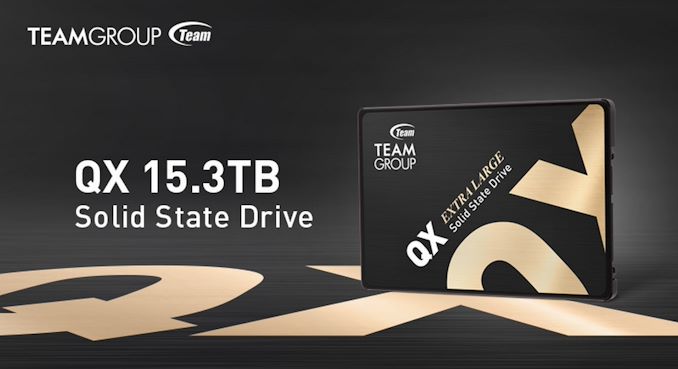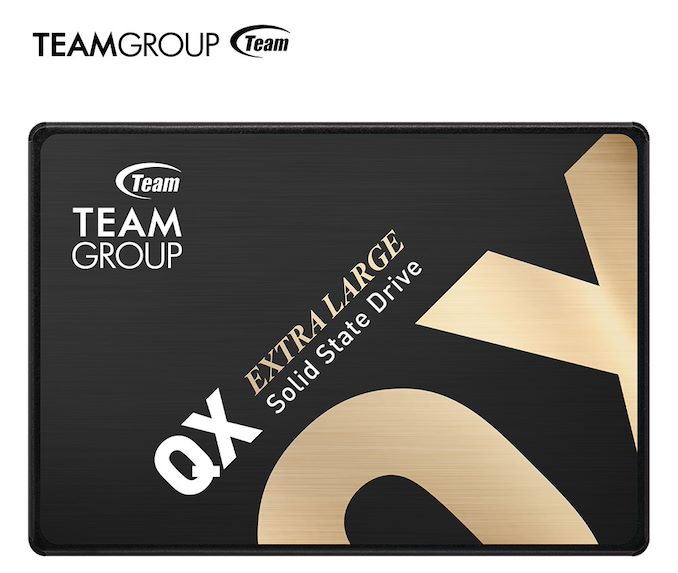TeamGroup Previews New 15.36 TB Consumer SATA SSD, for $3990
by Dr. Ian Cutress on September 2, 2020 7:00 AM EST
The two main angles that most SSD storage seems to be moving towards is performance or capacity. On the capacity front, we are starting to see the first 8 TB consumer drives coming to the market in a variety of formats. Always willing to jump ahead of the competition, TeamGroup has announced its new QX ‘Extra Large’ SSD coming in at 15.36 TB.
This new SSD is equipped with 3D QLC flash NAND, allowing it to hit the high capacity. The 2.5-inch drive has an SLC cache mode ahead of the DRAM buffer, which allows the drive to reach 560 MB/s reads and 480 MB/s writes according to the press release. The drive is rated under warranty for 2560 Terabytes Written, which comes down to 0.15 drive writes per day if the warranty is three years – TeamGroup has not specified any exact warranty at this time. At any rate, even with full sequential write speed, it would take around 60-70 days of continuous writes to go through that warranty.
Nothing else from TeamGroup’s press release seems out of the ordinary for a standard SATA SSD. We’ve reached out to ask exactly what SSD controller or NAND is under the hood, as these weren’t provided. There’s also no mention of IOPS. TeamGroup claims this drive is aimed at the consumer market, which it is only by virtue of it lacking a number of premium enterprise features. The price however is decidedly non-consumer: an eye-watering $3990 per drive, and the drives seem to be only made-to-order by OEM or SI clients. That’s $260 per TB of SATA SSD.
It has been confirmed that TeamGroup is using a Phison E12DC controller.
It’s worth noting that we discussed the NimbusData NL drive last week, which is also a high-capacity SATA SSD but geared up to the enterprise market. The 16 TB version of that drive is only $2900, a lot cheaper than this. The flip side of that is the 3.5-inch form factor of the NimbusData NL, compared to 2.5-inch (likely 15mm) for TeamGroup.
In the end, I’m of the opinion that TeamGroup is unlikely to sell many of these, except to niche customer bases, or laptop deployments perhaps – both of which are unlikely to be too keen on the ‘consumer’ designation.
Related Reading
- Nimbus Data’s New ExaDrive NL: 64 TB of Enterprise Grade QLC in 3.5-inch
- Crucial Launches X6 Portable SSD, Updates X8 with 2TB Model: QLC Drives for the Budget-Conscious
- The Samsung 870 QVO (1TB & 4TB) SSD Review: QLC Refreshed
- Enmotus MiDrive: Rethinking SLC Caching For QLC SSDs
- Western Digital Begins Shipments of 96-Layer 3D QLC-Based SSDs, Retail Products











26 Comments
View All Comments
Unashamed_unoriginal_username_x86 - Wednesday, September 2, 2020 - link
Next they're going to say it comes with 10th gen Intel and not Renoir. It's as if they don't want our money... And it looks like a router too! Big Navi will defenestrate this with a rusty prunerCullinaire - Thursday, September 3, 2020 - link
I miss the days when we joked about AGP slots instead...Kamen Rider Blade - Wednesday, September 2, 2020 - link
I'd rather buy a 16TB HDD at that point.https://www.newegg.com/toshiba-mg08aca16te-16tb/p/...
$376 and I can have multiple drives for redundancy given their asking price.
Tomatotech - Monday, September 7, 2020 - link
Call back when your 16TB HDD can serve 15TB of random 200KB database files / 2MB images at SSD speeds. With that kind of file distribution, a SSD will be around 100 times faster (no exaggeration) for 10x the price.4kB random file read:
Your Toshiba MG08 16TB HDD: 0.6ish MB/sec read.
860 Pro SSD (SATA not even NVME): 104 MB/sec.
For comparison, 0.6MB/sec is around the same speed as an average home internet connection around 10+ years ago. The 2.5" SSD is around 170 times faster.
16TB NVMe isn't here yet, but will probably be around 200-300MB/sec for random 4K. Something ridiculous like the Optane 905 1.5TB already does random 4K at 700MB/sec, if you have a spare kidney.
MDD1963 - Saturday, September 12, 2020 - link
And at only a $3500+ markup over a 16 TB spinning drive....! How 'consumer-ishly' priced, and so competitive! Spinning drives will be gone tomorrow! :)Polaris198321 - Tuesday, September 22, 2020 - link
Samsung needs this as well as NVME .2 versions for laptops going forward here for desktop mobos at 16TB in size here to help end the SSD space issues for future proofing issues here for multi usage laptops and desktops in gaming and media content creation here for YouTube and data science centers here. Once it becomes more mainstream here with 256GB RAM DDR5 and SODIMM RAM at 256GB for high end laptops for professionals and gamers in 240hz 4k HDR ai light sensing ability like on say a 8TB UHS-4 smartphone is needed for 4k and 8k high end video content creation and for storage here for video editing once the SSDs can be made with 3d printed self cooling materials here in both NVME .2 and SATA III versions here with the possibility of combining the RAM into the SATA III SSD itself in a combined unit here to save on space here on a laptop for a future cpu gpu and using other heated parts on the laptop mobo like on a smartphone cooling system that can also use the heat to convert to electricity to recharge the laptop battery after fixing the fire issue in the lition ion batteries on both smartphones and laptops here as getting all those parts into one part can help make the self recharging laptop possible here using heat generated from the gpu gpu and other hot parts of the system to recharge the battery here.